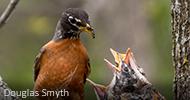The Golden Eagle is a powerful and long-lived predator with a strong attachment to its home: some return annually to the same nest for over twenty years. It hunts prey from squirrels to mountain goats, but also scavenges carrion when it has the opportunity.


Change media quality
Change image quality to reduce page loading times
 Golden Eagle
Golden Eagle
The Golden Eagle is broadly distributed across the northern hemisphere. Within Canada, it breeds primarily in alpine and prairie landscapes of western Canada, and in smaller numbers in the Hudson Bay Lowlands and eastern taiga. The North American population overwinters largely in the western United States, with smaller numbers in southern British Columbia, northern Mexico, and the eastern United States. There are approximately 23,000 individuals in Canada, representing 18% of the global population and a low degree of responsibility for Canada. An additional 40,000 individuals breed in Alaska and migrate to or through Canada, boosting the proportion of the global total to 49%, and corresponding to a moderate degree of responsibility. Considering both the Breeding Bird Survey and Christmas Bird Count, there is medium confidence that the population has undergone little change relative to 1970. The national population of Golden Eagle is within its goal range.






The Canadian population of Golden Eagle is not particularly well monitored. The best source of data is likely the Breeding Bird Survey (BBS), which provides only moderate coverage of the Canadian breeding range, but has high precision in its trend estimates for this species. The BBS trend for Canada shows some minor fluctuations over time, but overall only a small decline relative to 1970, well within the limits of being classified as little change. The continental trend from the Christmas Bird Count (CBC) indicates a moderate decline of 27% over the same period, but also in part reflects part of the population which remains in the United States year-round. At a regional scale, there is little difference in the trends among the western regions where the BBS data are sufficient for at least medium reliability. At two sites in Quebec contributing to the Raptor Population Index that have at least medium reliability, there have been moderate to large increases over more than three decades, but at some other Canadian sites with lower reliability, trends suggest little change or even declines. Overall, little change is most likely, but with medium confidence the trend could range between a moderate decrease and a moderate increase.
The goal for Golden Eagle is to maintain its population at or above the level it was at in the early 1970s, based on the Breeding Bird Survey. Recent data show that the population is within its goal range.
| Designation | Geographic Area | Status | CITATION |
|---|---|---|---|
| IUCN | Global | Least Concern | |
| Wild Species | Canada | Apparently secure |

The Golden Eagle is a powerful and long-lived predator with a strong attachment to its home: some return annually to the same nest for over twenty years. It hunts prey from squirrels to mountain goats, but also scavenges carrion when it has the opportunity.
Golden Eagle is reported throughout the year in Canada, with slight peaks during early spring and late fall migration.
Nesting period starts between early February and early April and ends between early August and late August, depending on the region. Before or after this period, the probability of an active nest is lower.







